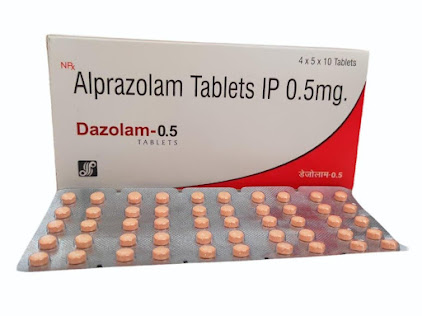Study about (Alprazolam)
Alprazolam
Alprazolam is a medication classified as a benzodiazepine,
primarily prescribed to address anxiety and panic disorders.
It exerts its effects by modulating the activity of
neurotransmitters in the brain, particularly gamma-aminobutyric acid (GABA),
leading to a calming and relaxing influence on the central nervous system.
· Clinical
uses
· Dosage
· Mechanism
of action
· Absorption
· Metabolism
· Half-life
· Route
of administration
· Contraindication
· Side
effects
· Toxicity
Clinical
uses
· Alprazolam
is often prescribed for generalized anxiety disorder (GAD).
· It
may be used to manage symptoms of social anxiety disorder.
· Alprazolam
is effective in the treatment of panic disorder with or without agoraphobia.
· Sometimes,
it may be used as a short-term treatment for insomnia.
· It might be part of a treatment plan for certain medical conditions where anxiety plays a significant role.
Dosage
Anxiety disorder:
·
Adult: PO
0.25-0.5 MG t.i.d.
(max:
4mg/d);
·
Geriatric: PO
0.125-0.25 mg b.i.d.
Panic Attacks:
·
Adult: PO
1-2 mg t.i.d.
(max:
8mg/d);
Mechanism
of action
· Alprazolam
is a triazolobenzodiazepine used to treat certain anxiety and panic
disorders. Alprazolam acts on benzodiazepine receptors BNZ-1 and BNZ-2.
The active metabolites 4- hydroxyalprazolam acts on these receptors with 0.20
times the potency of alprazolam and alpha-hydroxyalprazolam acts on these
receptors with 0.66 times the potency.
· The
effect of alprazolam on BNZ-1 mediates the sedation and anti-anxiety effects of
the drug while the action on BNZ-2 mediates effects on memory, coordination,
muscle relaxation, and anticonvulsive activity.
· Alprazolam
also couple with GABA-A receptors to enhance GABA binding to its receptor.
This interaction mediates inhibition of the nervous system and results in a
calming effect.
Absorption
· Oral
bioavailability of a standard release tablet of alprazolam is 84-91% with a time to
maximum concentration of 1.8 hours.
· A
1mg oral dose of alprazolam leads to a maximum plasma concentration of 12-22mcg/L.
· Alprazolam is rapidly absorbed in the gastrointestinal tract.
Metabolism
· Alprazolam
is metabolized to less effective metabolites by various CYPs includin, CYP3A4,
CYP3A5, CYP3A7, and CYP2C9.
· The majority of alprazolam metabolism is mediated by hydroxylation vi CYP3As. 4-hydroxyalprazolam has 20% the binding affinity of the parent drug alpha-hydroxy alprazolam has 66% the affinity, and the benzophenone metabolite has <1% affinity.
Half-Life
· The half-life
is 16.3h in
the elderly,
• 5.8-65.3h in patients with alcoholic liver disease,
• 9.9-40.4h in obese patients.
• The half-life is 25% higher in Asian patients
compared to Caucasians.
• Other studies have shown the half-life to be 9-16h.
Rout
of administration
· Alprazolam
is mainly eliminated in the urine.
· A
large portion of the dose is eliminated as unmetabolized alprazolam.
· 10% of the dose is eliminated as alpha-hydroxy-alprazolam and 4- hydroxy-alprazolam.
Contraindication
· Acute
alcohol intoxication with depressed vital signs,
· acute angle closure
glaucoma,
· myasthenia gravis,
· severe COPD,
· hypersensitivity,
· pregnancy and lactation.
Side effects
· Frequent:
Ataxia, light- headedness, transient mild somnolence, slurred speech.
· Occasional:
Confusion, depression, blurred vision, constipation, diarrhoea, dry mouth,
headache nausea.
· Serious reactions: abrupt or too rapid withdrawal may
result in
· pronounced restlessness, irritability, insomnia, hand tremors, abdominal and muscle cram, diaphoresis, vomiting and seizures. Over dose results in somnolence, confusion, diminished reflexes and coma.
Toxicity
· Alprazolam
overdose can present as sleepiness, confusion, poor coordination, slow reflexes, coma,
and death.
· Taking
alprazolam with alcohol lowers the threshold for overdose.
· Patients
should have their respiration, pulse, and blood pressure monitored.
· Patients
can be treated by gastric lavage and intravenous fluids.
· If
hypotension occurs, patients may be treated with vasopressors.
· In
known, or suspected overdoses, patients can be given the benzodiazepine
receptor antagonist flumazenil in addition to other methods of management.
· Alprazolam
is a pregnancy
category D teratogen meaning there is evidence of risk to the
fetus of a mother taking alprazolam but in some cases the benefit may outweigh
the risk.
· Children
born to these mothers are also at risk of withdrawal symptoms, flaccidity,
and respiratory issues.
· Benzodiazepines
are expressed in human breast milk and so nursing is generally not recommended
in mothers taking alprazolam.
· Alprazolam is not associated with carcinogenicity, mutagenicity, or impairment of fertility.











Nice
ReplyDeleteWell done 👍
ReplyDeleteNice 👍
ReplyDelete👍
ReplyDeleteExcellent
ReplyDeleteWell 👍
ReplyDeleteExcellent 👍
ReplyDelete